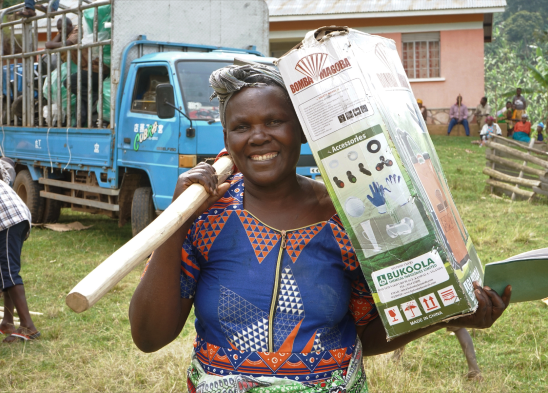Responding to the Rising Food Insecurity During COVID-19
Our evaluation team has been monitoring the impact of Covid-19 on household income and consumption in rural Uganda, as part of a randomized control trial conducted by the Department of Economics at Oxford University. Even at the early stages of the pandemic, the findings revealed rapid depletion of household savings, increased borrowing, and growing near-term deficits.
The increased consumption of immature crops has further compounded future food insecurity. While the study indicates household hunger has increased, assets and livestock have not yet been liquified. If these deficits are addressed in a timely manner, there’s an opportunity to soften the long-term effects of the pandemic by addressing the immediate need for food.
To respond to the emerging crisis, Raising The Village mobilized swiftly to roll out our Ready-To-Eat (RTE) Initiative. Phase I supported more than 220,000 partner communities in 2020. After the success of and overwhelming response to the first phase, Phase II of the Initiative was launched in early 2021 and we were able to reach more than 1,000,000 people in less 10 weeks across the country.
What are Ready-To-Eat Garden Boxes?
Ready-To-Eat (RTE) garden boxes aim to provide a sustainable food supply for a family of 5 with at least 1 nutritious meal per day over 12 months. Each kit costs $1.50 USD, and consists of 150 vegetable seedlings designed to maximize a 5×5 metre garden, or fill existing household items such as jerry cans or old sacks. The kits are designed to de-risk crop rearing at the most vulnerable growth stage. RTE garden boxes are a reliable and repeatable food source for the family.

Key Design Components
1. Combination of readily available seed for 12 vegetables: white eggplant, cabbage, nakatu, sukuma wiki, spinach, purple eggplant, black nightshade, pumpkin, carrot, beetroot, amaranth, and spider plant, as well as hot pepper for natural pesticide. Combinations may be adjusted based on a review of local growing conditions.
2. Crops are selected based on plant hardiness, rate of maturity, sustained harvest yield, ease of use and maintenance, capacity for plants to bolt seeds for future household use, nutrition, and caloric intake.
3. Kits include “Do it Yourself” take-home materials that offer a visual guide for planting, care, harvest, and bolting, using available household items.

Implementation Approach
1. Villages are grouped into clusters based on geography, shared infrastructure, and administration. Nurseries that are 1-2 acres in size serve as localized distribution points, each serving 1,500-2,000 households. Communities designate the land and support with preparation, planting, and the construction of nursery beds.
2. We equip clusters with manure, organic pesticides, and farming equipment, and closely monitor the crops to minimize risk during the most vulnerable stage. Watering, weeding, and additional labour are managed by community members.
3. Training and the distribution of learning materials focuses on the core components of transplant care, harvesting, and bolting.
4. When seedlings are ready for transplant, scheduled village distribution helps ensure physical distancing and improved seedling survival rates. Registered households use available household items to transport the plants. If necessary, secondary drop points at villages are completed using short-haul delivery with motorbikes.

Schedule and Phased Application
The RTE initiative is implemented through a series of phases, based on the resources, capacity, and need within our existing area of operation. Phase 1 targets 45,000 households in our current areas of operation in western Uganda, representing a population of 220,000 direct beneficiaries over 3 months. Based on the need, we will have additional capacity to reach 100,000 households and 500,000 people in the region.

- DESIGN COMPONENTS
-
Key Design Components
1. Combination of readily available seed for 12 vegetables: white eggplant, cabbage, nakatu, sukuma wiki, spinach, purple eggplant, black nightshade, pumpkin, carrot, beetroot, amaranth, and spider plant, as well as hot pepper for natural pesticide. Combinations may be adjusted based on a review of local growing conditions.
2. Crops are selected based on plant hardiness, rate of maturity, sustained harvest yield, ease of use and maintenance, capacity for plants to bolt seeds for future household use, nutrition, and caloric intake.
3. Kits include “Do it Yourself” take-home materials that offer a visual guide for planting, care, harvest, and bolting, using available household items.

- IMPLEMENTATION
-
Implementation Approach
1. Villages are grouped into clusters based on geography, shared infrastructure, and administration. Nurseries that are 1-2 acres in size serve as localized distribution points, each serving 1,500-2,000 households. Communities designate the land and support with preparation, planting, and the construction of nursery beds.
2. We equip clusters with manure, organic pesticides, and farming equipment, and closely monitor the crops to minimize risk during the most vulnerable stage. Watering, weeding, and additional labour are managed by community members.
3. Training and the distribution of learning materials focuses on the core components of transplant care, harvesting, and bolting.
4. When seedlings are ready for transplant, scheduled village distribution helps ensure physical distancing and improved seedling survival rates. Registered households use available household items to transport the plants. If necessary, secondary drop points at villages are completed using short-haul delivery with motorbikes.

- SCHEDULE
-
Schedule and Phased Application
The RTE initiative is implemented through a series of phases, based on the resources, capacity, and need within our existing area of operation. Phase 1 targets 45,000 households in our current areas of operation in western Uganda, representing a population of 220,000 direct beneficiaries over 3 months. Based on the need, we will have additional capacity to reach 100,000 households and 500,000 people in the region.




